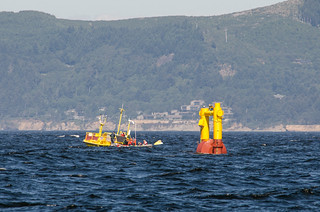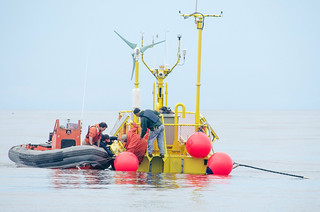
OSU Ocean Sentinel (right) and WetNZ buoy (background) sit in Port of Toledo Boatyard awaiting deployment at sea. (Photo by Pat Kight, Oregon Sea Grant)
Possible locations for a new “grid-connected” wave energy testing facility off the Oregon coast will be the topic of discussion at community forums next week in Newport, Reedsport and Coos Bay.
Dubbed the Pacific Energy Center, the facility would connect offshore energy-generating devices to the electric grid in what’s expected to be the final step of testing whether it’s feasible and cost-effective to generate power from ocean waves.
The free public forums, sponsored by the Northwest National Marine Renewable Energy Center (NNMREC) at Oregon State University, will take place from 5:30-7:30 pm at
- The Hatfield Marine Science Center in Newport (Aug. 20)
- Pacific Auditorium in Reedsport (Aug. 22)
- Coos Bay Public Library, Coos Bay (Aug. 23).
Funded in part by the US Department of Energy, NNMREC is taking the lead in testing the scientific, technical and practical aspects of generating electricity via the movement of the ocean’s waves. A partner program at Washington State University is doing the same with tidal energy devices.
Within a week, the OSU-developed Ocean Sentinel testing platform is expected to be deployed to a designated testing zone two miles off Yaquina Head, on the central Oregon coast – and with it, its first test subject, a wave-energy generation buoy dubbed “WetNZ.”
The Ocean Sentinel is equipped to test multiple generating devices at once and transmit the data back to NNMREC labs for analysis. It is not, however, set up to feed generated energy into the power grid. For that, underwater cable is required.
That would be the job of Pacific Marine Energy Center, still several years in the future and awaiting final approval of a $4 million DoE grant for detailed study and design work. Meanwhile, the process of finding a suitable site is under way. Locales under consideration are off Newport, Reedsport, Coos Bay, and Camp Rilea near Warrenton, all of which have characteristics that could make them suitable for the project.
“We’ve already been talking with community leaders and other officials for some time about this project, and now we want to broaden the discussion, hear more viewpoints,” said Kaety Hildenbrand, Oregon Sea Grant’s marine fisheries Extension specialist and one of the organizers of the community meetings.
“The purpose of these forums is to help people understand what we’re trying to do, and listen to their interests, questions and concerns,” said Hildenbrand, who has worked with coastal communities on energy siting issues for several years. Much of her work focuses on the effects such large-scale uses of ocean space can have on local communities, economies and people, many of whom earn a living through fishing and other more conventional uses. “One part of our goal is simple. We want to find a good fit, a situation where most residents want this facility and feel positive about it.”
Learn more:
 CORVALLIS, Ore. – The communities of Newport and Reedsport, Ore., have been chosen as the two finalists for the possible location of the Pacific Marine Energy Center (PMEC), a planned $25 million, “grid-connected” wave energy testing facility in the Pacific Northwest.
CORVALLIS, Ore. – The communities of Newport and Reedsport, Ore., have been chosen as the two finalists for the possible location of the Pacific Marine Energy Center (PMEC), a planned $25 million, “grid-connected” wave energy testing facility in the Pacific Northwest.





